CAPITOL REEF (Day 15 - part 6)
We reached the paved road again and headed back up the scenic drive to Fruita.





This formation is known as the Egyptian Temple.



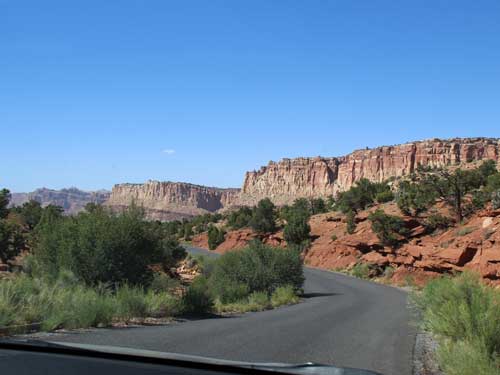
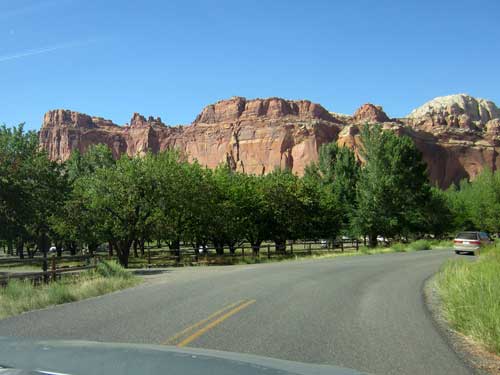
The orchards of Fruita
You are actually allowed to pick the fruit that is in season. It's free to sample within the orchard but there's a small fee if you want to take some with you. We pulled in to grab a few apricots to taste.

The orchards were planted by the early settlers. There are around 3,100 trees including cherry, apricot, peach, pear, apple, plum, mulberry, almond and walnut.
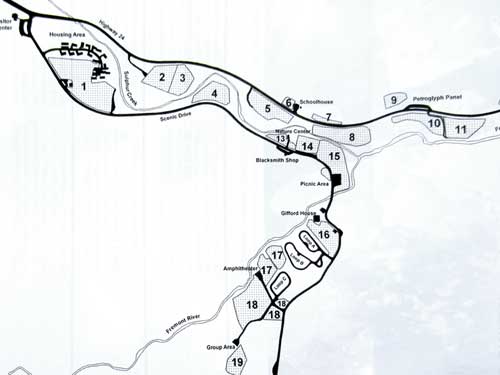
We were at #18, the Cass Mulford orchard. Clarence (Cass) Mulford was one of town's most important growers from the 1930's - 60's. He also rented out horses and gave guided trail rides through the monument. (click for a larger view)

Apricot trees


Grabbing a few samples

Absolutely delicious!!
We headed out to a few more sites on the eastern side of the park.
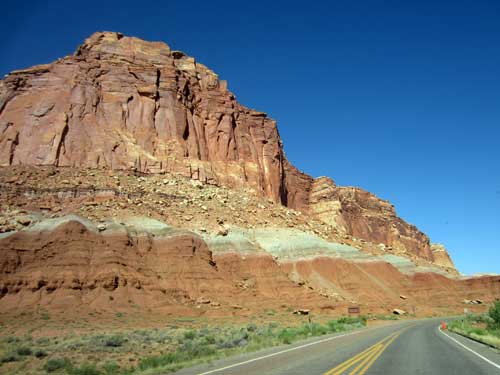
The one-room school was built in 1896. Being Fruita's only public building, it also served as a church, meeting house and community center. The students' desks were not attached to the floor so they could be moved out of the way for church gatherings, dances and other social events. The last students were taught here in 1941, after which the school was closed and they were bused to other schools in the county. It was renovated in 1966.
Students, ranging across eight grade levels, were taught by one (usually new and inexperienced) teacher. Teachers often stayed no more than one year due to the isolation and limited support. School only occurred after all the faming needs were finished, usually from November to April.


The class of 1924-5. Over the years, class size steadily declined.... from 26 down to just 8 students.
Unfortunately the building was closed and the light was a bit too harsh to see much through the windows. But we glimpsed what we could.

1872 rules for teachers
1) Teacher each day will fill lamps, clean chimney.
2) Each teacher will bring a bucket of water and scuttle of coal to each day's session.
3) Make pens carefully. You may whittle nibs to the individual taste of the pupils.
4) Men teachers may take one evening each weak for courting purposes, or two evenings a week if they go to church regularly.
5) After 10 hours in school, teachers may spend the remaining time reading the Bible or other good books.
6) Women teachers who marry or engage in unseemly conduct will be dismissed.
7) Every teacher should lay aside from each pay of goodly sum of his earnings for his benefit during his declining years so that he will not become a burden os society.
8) Any teacher who smokes, uses liquor in any form, frequents pool or public halls, or gets shaved in a barber shop will give good reason to suspect his worth, intention, integrity and honesty.
9) The teacher who performs his labor faithfully and without fault for five years will be given an increase of 25 cents per week in his pay, providing the Board of Education approves.

A list of punishments from November 1848 (in terms of number of lashes):
Playing at cards at school - 10
For misbehaving to girls - 10
For drinking spiritous liquors at school - 8
Telling tales out of school - 8
Telling lies - 7
Making swings and swinging on them - 7
For playing about the mill or creek - 6
Fighting or quarreling at school - 5
Boys and girls playing together - 4
Giving each other ill names - 3
For wearing long finger nails - 2
Coming to school with dirty faces and hands - 2
Climbing for every foot over three up a tree - 1
Our next stop was the petroglyph site.


Thousands of years before the arrival of the Europeans. ancient peoples farmed and hunted here. Eventually they became potters and rock masons, stored food in granaries to survive the seasons, and lived in seasonal pit houses. Spare time was devoted to making jewelry, weaving baskets and creating stories in stone.
They settled in small groups consisting of several families and never built large cities. These groups gradually changed over time, merging and dispersing. This constant reshuffling resulted into today's tribal groups of Utes, Paiutes, Hopi, Navajo and Zuni. Known by archeologists as the Fremont Culture (named after the Fremont River where the first sites were discovered), the Hopi call them Hisatsinom (People of Long ago) and the Paiute know them as the Wee Noonts (People Who Lived the Old Ways).
They inhabited the Capitol Reef area from about 250 to 1275. Despite their success, there is no evidence as to why their culture ended. Some archeologists think they left because of warfare, drought or depletion of resources and were assimilated into other cultures. The Hopi believe they left in order to complete their migrations to Tuuwanasavi, the center of the universe. During this same time, there was lots of cultural change and population movement throughout the entire Southwest.

Pictographs (painted on rock surfaces) and petroglyphs (carved into the rock) depict people, animals and abstract designs. They describe daily life, journeys, clan symbols, deities, calendars, prey, past events and legends.

Click for a larger view


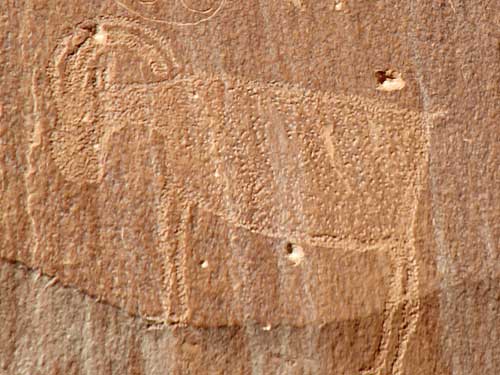
A bighorn sheep


In early 1952, some large petroglyphs were destroyed by a natural rockfall. Before (left) and after.


Here are some more Cooks, including James again from the Pioneer Register from the Capitol Gorge hike. According to records, a James H Cook married a Rebecca Roberts in Wayne (the county we are in now) on Jan 3, 1911. He was 21 and she was 19. Could this be our guy? Is Maxie a relative as well? Some questions will never be answered.
We then returned back out the park the way we had come, eventually arriving at our motel in Bicknell.


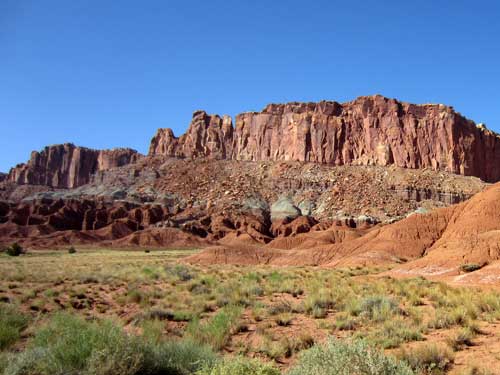



Chimney Rock again
To read about my previous visit to Capitol Reef in 2014, visit my
California trip
|


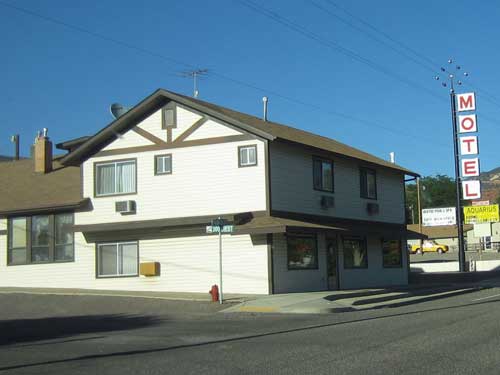


The room came with a DVD player and even a VCR since attached to the motel was a video rental store.

Handy dispensers were also in the shower filled with soap and shampoo.
Down the street, across from Wayne High School, was a cute little pizza place called the Badger Den.


The decor was of the local school's sports teams.


Mmmmmm!
return • continue

